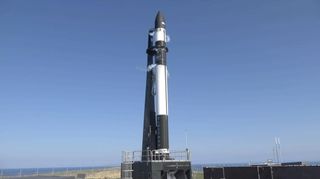Rocket Lab Scrubs Launch of Experimental DARPA Military Satellite

The small-satellite launch company Rocket Lab called off the planned flight of an experimental satellite for the U.S. military Sunday (March 24) due to a video transmitter issue.
Rocket Lab was counting down to a 7:36 p.m. EDT (2336 GMT) launch of its Electron booster from Launch Complex 1 on New Zealand's Māhia Peninsula when the glitch occurred, the company said in Twitter update.
"The team has identified a video transmitter 13dB down with low performance," Rocket Lab said in the Twitter post. "It's not an issue for flight, but we want to understand why, so we're waiving off for the day."
Related: Rocket Lab's 1st Commercial Launch in Pictures

The Electron is carrying the prototype R3D2 space antenna in a test flight for the Defense Advanced Research Projects Agency.
R3D2's seemingly "Star Wars" droid-inspired name is short for Radio Frequency Risk Reduction Deployment Demonstration. The spacecraft carries a novel antenna design that is tightly packed for launch and will unfurl to a span of 7.3 feet (2.3 meters) once fully deployed.
The antenna is made of an ultra-thin Kapton membrane, which will be tested for its communications effectiveness on this flight, DARPA officials have said. The entire R3D2 satellite weighs about 330 lbs. (150 kilograms).
Get the Space.com Newsletter
Breaking space news, the latest updates on rocket launches, skywatching events and more!
"R3D2 will monitor antenna deployment dynamics, survivability and radio frequency (RF) characteristics of a membrane antenna in low-Earth orbit," DARPA officials said in a statement. "The antenna could enable multiple missions that currently require large satellites, to include high data rate communications to disadvantaged users on the ground."
- Rocket Lab Launches 13 Cubesats on 1st Mission for NASA
- Rocket Lab Picks Virginia Spaceport As US Launch Site for Small Satellites
- Changing the Launch Equation: Q&A with Rocket Lab CEO Peter Beck
Email Tariq Malik at tmalik@space.com or follow him @tariqjmalik. Follow us @Spacedotcom and Facebook.
Join our Space Forums to keep talking space on the latest missions, night sky and more! And if you have a news tip, correction or comment, let us know at: community@space.com.

Tariq is the Editor-in-Chief of Space.com and joined the team in 2001, first as an intern and staff writer, and later as an editor. He covers human spaceflight, exploration and space science, as well as skywatching and entertainment. He became Space.com's Managing Editor in 2009 and Editor-in-Chief in 2019. Before joining Space.com, Tariq was a staff reporter for The Los Angeles Times covering education and city beats in La Habra, Fullerton and Huntington Beach. In October 2022, Tariq received the Harry Kolcum Award for excellence in space reporting from the National Space Club Florida Committee. He is also an Eagle Scout (yes, he has the Space Exploration merit badge) and went to Space Camp four times as a kid and a fifth time as an adult. He has journalism degrees from the University of Southern California and New York University. You can find Tariq at Space.com and as the co-host to the This Week In Space podcast with space historian Rod Pyle on the TWiT network. To see his latest project, you can follow Tariq on Twitter @tariqjmalik.
